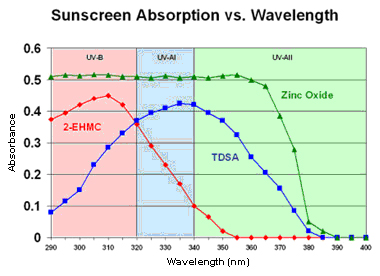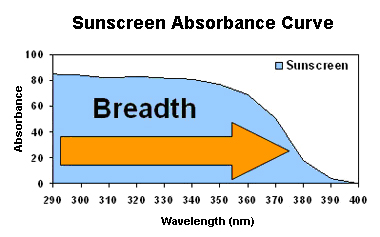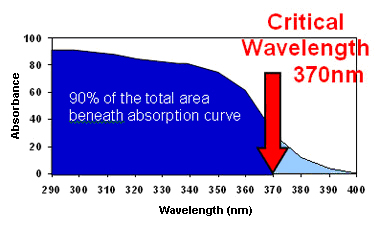What Is Critical Wavelength and Why Is It So Important ?
The UV absorbance of a sunscreen product can be determined in vitro over the entire UV spectrum (290nm – 400nm) using substrate spectrophotometry. A uniform amount and thickness of sunscreen is applied to a glass slide and exposed to UV light; the absorbance of that UV radiation is measured. The graph below is an example that approximates the absorbance curves of a UVB sunscreen (2-EHMC, 5%), a UVA sunscreen (TDSA, 5%), and a broad spectrum sunscreen (zinc oxide, 20%).

This UV absorbance curve demonstrates the amplitude and breadth of protection provided (from 290nm – 400nm) across the UV spectrum.
The shape of the resultant absorbance curve represents the efficiency at which a sunscreen product blocks a given UV wavelength with respect to another.
Interpreting the Absorbance Curve
The “amplitude” (vertical height) of the absorbance curve reflects the degree of protection. The higher the amplitude of the curve, the greater the absorbance, and the more protection provided at that wavelength. Within the UVB portion of the spectrum (290nm – 320nm) this amplitude correlates with the SPF.
The greater the “breadth” of the curve, the more protection provided against longer wave UV radiation. In other words, the greater the “breadth” of the curve, the broader the spectrum of sun protection provided. Sunscreen products that provide broad spectrum protection have broad (wide) absorbance curves that extend over the majority of the UV spectrum.
Calculating Critical Wavelength (λc)
Mathematical integration of the measured spectral absorbance from 290nm to 400nm is performed to calculate the area beneath the curve. The “Critical Wavelength” (λc) is the wavelength below which 90% of the area under the absorbance curve resides.
The Importance of Critical Wavelength
The critical wavelength determination does not promote the false idea that UVB and UVA are separate entities, but rather are part of the continuous electromagnetic spectrum. The critical wavelength for a UVB sunscreen is less than that for a sunscreen that protects against both UVB and UVA. A higher critical wavelength ensures more UV protection, especially protection from longer wavelength UVA rays. For example, a sunscreen with a critical wavelength of 370nm provides more protection against UVA rays than a sunscreen with a critical wavelength of 350nm. Calculation of the critical wavelength provides a convenient and reproducible method of evaluating the breadth of UV protection. When combined with in vivo SPF testing, the critical wavelength provides a simple and explicit means of communicating broad-spectrum photoprotection to the consumer.
The critical wavelength value is based upon the inherent shape and breadth of the absorbance curve, not its amplitude, and therefore is independent of application thickness. Although SPF and critical wavelength are largely independent of each other, UV-A absorbance must increase commensurate with SPF to maintain the same critical wavelength value.
This is very important, and is why it is more difficult to produce a truly ‘broad spectrum’ sunscreen with a high spf and a high (> 370nm) critical wavelength. A study published in the Journal of The American Academy of Dermatology (43(6), Dec 2000) evaluated 59 commercially available sunscreen products, and found that only 10 % achieved a critical wavelength of at least 370nm. These products all contained at least one UV-AI filter: zinc oxide, titanium dioxide, or Avobenzone (Parsol 1789). However, not all of the products containing these UV-AI sunscreen ingredients achieved a critical wavelength of 370nm. This proves that effective concentration and appropriate formulation are essential to a sunscreen product’s effectiveness. Simply including UV-AI filters in a formulation does not ensure a true broad-spectrum product.
Critical Wavelength > 370nm is Necessary for “Broad Spectrum” Coverage
A critical wavelength > 370nm is a rigorous minimum that sunscreen products should achieve to be labeled as “broad-spectrum”. The combination of in vivo SPF rating and critical wavelength provides a complete description of a product’s inherent photoprotective characteristics; SPF describes the amplitude of protection (at a given application thickness), and critical wavelength provides a reliable measurement of a product’s absorption capability over the entire UV spectrum. No other efficacy measurements are needed.
Current FDA Regulations Now Require Critical Wavelength
The difficulty when shopping for sunscreens is that unless the consumer is familiar with the different ingredients (chemical and inorganic), and understands which portion of the UV spectrum each ingredient works in, he or she must rely on the product labeling to understand what degree of coverage is provided. Since sunscreen labeling (until recently) has not been regulated, consumers have not had any consistent way to determine the quality and efficacy of UVA protection provided by a sunscreen product.
Sunscreen labels often include the terms “UVB and UVA”. The amount of UVB coverage is indicated by the SPF number on the label. However, there is no way to determine the degree of UVA coverage. That “UVA” printed on the label might mean that there is a single ingredient that covers only a small part of the short UVA rays (320nm – 340nm), or that there is one or more ingredients that covers the majority of the UVA spectrum (320nm- 400nm). The UVA coverage provided by these sunscreens is completely different – but without detailed knowledge of the specific ingredients, the average consumer has no idea which to choose. Thankfully, over the last 10 years, labels are not as misleading, sunscreens have improved, and more products are now providing better and more complete UVA protection.
The help clarify the amount of UVA protection, and to specifically identify those sunscreens that do provide ‘broad spectrum’ coverage, the FDA has employed the critical wavelength test. Under the new FDA regulations, that took effect in mid-December 2012, a sunscreen can only claim to provide ‘broad spectrum’ coverage if it has a critical wavelength greater than 370nm.





